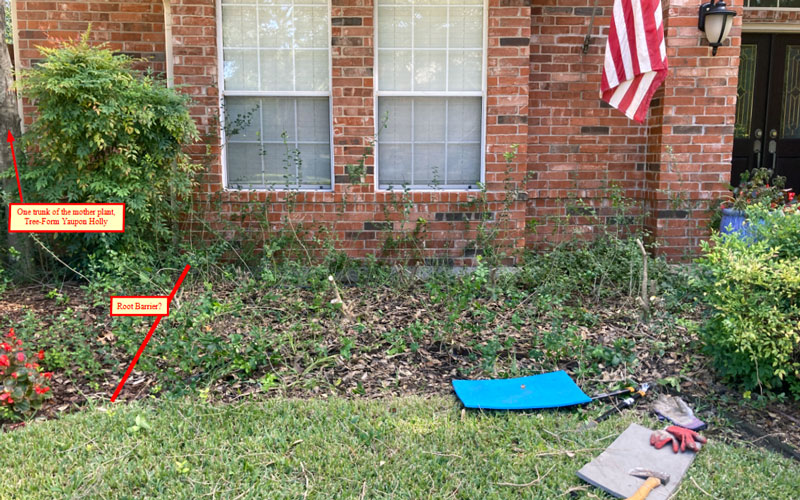Q&A – Ask Neil: November 24, 2022
(Please read these instructions carefully.)
Before you post your question, please look at recent issues to see if someone else has already asked it. You might find your answer there.
How to submit your question…
• Click here to post your question. After you submit your question, a new window will pop up giving you the address to which you can e-mail a photo to accompany your question. Clear, medium-resolution photos. (Try to avoid low-res thumbnail photos, please, in case I have to zoom in to see things.)
• Please only post your question one time.
• One question per reader, please.
• Please use this only for posting questions – not for standard emails.
• Watch for your answer in the following week’s e-gardens.
• I choose those of greatest general interest. For example, plant IDs seldom make the cut.
• I must have your first name or initials.
• I must have your city or county. (Texas is a very large state.)
QUESTION 1
SHOULD RADIAL SHAKE DAMAGE BE SPRAYED WITH PRUNING SEALANT?
Question: In light of last week’s information on radial shake on live oak trunks, if one of my live oaks has shed its bark in a small area, should that area be sprayed with pruning sealant or just left on its own? Clif O., Fort Worth.
Answer: Left on its own. It will heal more quickly if the wood is left open. Watch for a roll of new bark to start form across the open wound.
QUESTION 2
IF BARK IS PEELING OFF A PISTACHIO TRUNK SHOULD I BE CONCERNED?
Question: The bark on my 15-year-old Chinese pistachio looks like it’s peeling off the tree. It’s been like this for several years. Should I be concerned? Cristina O., McKinney.
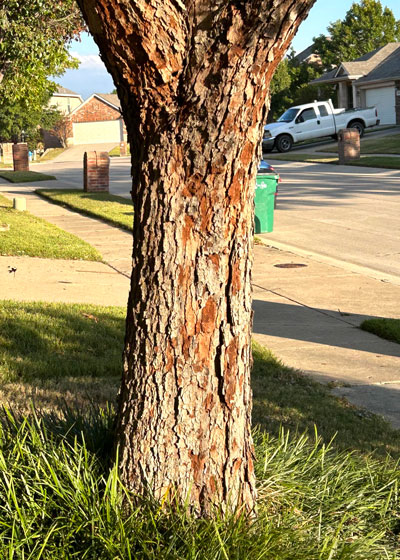
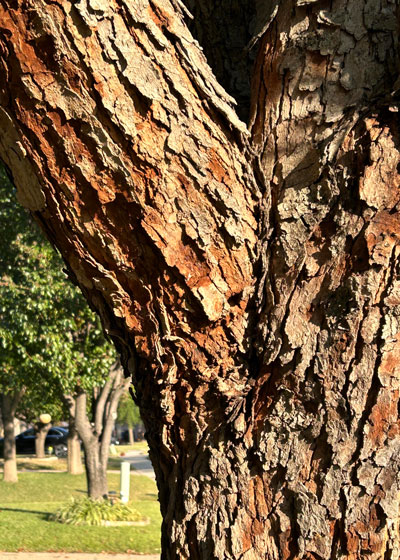
Answer: Not if the tree has remained vigorous all of that time. Bark is a dead tissue and as a tree’s trunk grows larger all the bark can do is to pop off and fall to the ground. I’m very slightly concerned about the two elongated vertical cracks toward the right side of the trunk in the top photo, but to restate it: if the top growth has continued to look healthy, the tree should be fine.
QUESTION 3
DO I NEED TO DRAIN MY SPRINKLER SYSTEM?
Question: Every year I drain my sprinkler system and turn it off for the winter. You suggest leaving it in the “Manual” mode. Do I really need to drain it? Tom S., Belton.
Answer: I have never drained my system in 42 years, and I live 4 hours north of you. Unless you have water standing in heads so that it could be ruptured by freezing water, I see no need to drain them. Conversely, I have ruined several hose-end sprinklers by accidentally leaving them out in freezing weather. Those are the ones that need to be drained and stored in the garage.
QUESTION 4
HOW CAN I STOP YAUPON HOLLY ROOT SPROUTS?
Question: Yaupon holly root sprouts have traveled up to 15 feet into a bed where I want to plant Carissa hollies. How can I clear them out and prevent more? Can I block them with a 1-foot-deep root barrier? Will the sprout remnants grow back? Patrick M., Plano.
Answer: I’ve grown yaupons all my adult life and I’ve never seen them spread that far. I think your plan is good. You’re going to need to rototill the narrow, empty part of the bed and rake out the root pieces first, however. Your new Carissas deserve that extra effort even if the yaupon roots weren’t involved. Try to find the offending root from the mother yaupon and remove it even farther back to the left. Yes, the root barrier should go at least 12 inches deep, perhaps more. You could use corrugated fiberglass inserted into a trench. It would do the job very well.
QUESTION 5
WHY WOULD TIPS OF MAGNOLIA’S LEAVES TURN BROWN?
Question: I have a large magnolia tree on the west side of our house (full sun from 2 PM on). From the top of the tree the tips of the leaves turned brown (in mid-summer) and still have not recovered. What might be troubling my tree? Janet M., Royse City.
Answer: Any time you have tip- or edge-burn of leaves it points to moisture stress, whether it’s a houseplant or a shade tree. Those are the parts of the plant that are farthest from the roots, so they get dry first and get water last. But narrowing the cause down any farther becomes much more challenging. Owing to the summer we just went through the tree may have gotten too dry. It could also be from root damage, too much fertilizer, trunk or root damage or even weedkiller damage, for example from Atrazine. Hopefully it will leaf out naturally in the spring and all will be well once again. Hopefully there will be enough rain that there won’t be any more scorching.
QUESTION 6
WHAT CAN I DO FOR A TREE WHERE A LOST LIMB WAS FILLED IN?
Question: I bought a house where a tree had lost a limb. A gap was filled in with spray stuff. The tree does seem to be surviving, but I’m sure that was not a good idea. It’s also unsightly. How can I correct this? Nigel G., Yantis.
Answer: I surely wish I had a photo. Filling a void in that manner is bad news. It can trap moisture and harbor decay and insect pests. It does nothing to strengthen the trunk. Your goal is to help the tree grow across the gap and form solid new bark, so anything you can do to help that is in the tree’s best interest. Perhaps you could use a sharp chisel of small grinder to make it look better, but don’t be too aggressive in cutting. The trunk is probably weakened already. You would be well served if you could find a certified arborist to look at the tree with you.
QUESTION 7
IS THIS PART OF THE HEALING PROCESS?
Question: This red oak was planted 2-1/2 years ago. The trunk was not wrapped and in the winter of 2020 it suffered sunscald. Arborists are now feeding it via ground injection and treating it with Merit. The base now shows loose fibers. Is this part of the healing process? Robert L., McKinney.
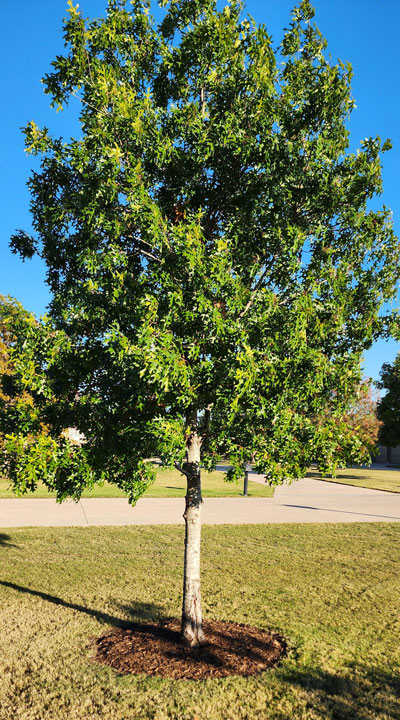
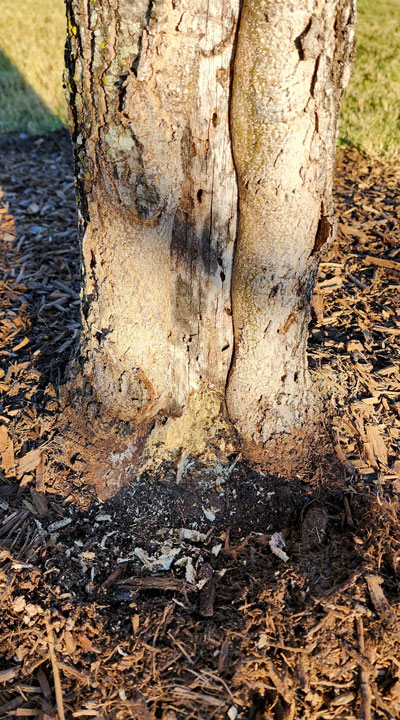
Answer: I’m not sure what you’re calling “loose fibers,” but I definitely see signs of borer invasion into the damaged wood. However, your distant photo shows the tree to be in reasonably good health. It sounds like the arborist is doing good things for it. The roll of new bark you see forming from the right side is what you want to see. I wish we had an equal roll coming in from the left. Hopefully that will happen fairly soon. The tree will always have a weak area within its trunk. Hopefully it will form solid wood within the new growth. Good luck, and remember always to wrap trunks of all new oaks, Chinese pistachios, red maples and other thin-barked trees in the future.
QUESTION 8
I ALWAYS HAVE VINES FILLED WITH UNRIPE TOMATOES IN THE FALL. WHAT AM I DOING WRONG?
Question: For years I’ve heard that fall tomatoes are wonderful. I’ve tried to grow them many times, but I always have vines heavy with unripe tomatoes when the first frost wipes them out. Where am I missing out? Matt H., Argyle.
Answer: It’s one of three things. First, you may be planting too late. For DFW Argyle the planting dates are June 25-July 4. That sounds quite reasonable now, but when that time rolls around next June it will seem impossibly early. But do the math and you’ll realize that it’s a requirement because many years we have killing frosts (which can happen at 36F or 38F) as early as late October.
Second, you may be planting the wrong varieties. You want small or mid-sized varieties. Large tomatoes won’t set fruit when it’s hot and they quit setting fruit when it turns cool, so you want to avoid types like Big Boy and Beefsteak. They’re also very slow to mature, especially in cool weather.
Third, you may not be pushing your plants to grow vigorously during the summer. If you let them poke along they will be late to bloom and late to set fruit. Keep them moist at all times, and fertilize them every couple of weeks with a high-nitrogen, water-soluble plant food.
Hopefully you’ve seen the discussions that on the night of the first freeze you can lay many green tomatoes out on towels and allow them to ripen without their losing flavor or nutritional value. Choose a representative size and cut through it with a very sharp knife. If the knife blade cuts cleanly through the seeds that tomato and others like it would not have ripened. If it pushes the seeds aside in the gelatinous mass, that fruit would go ahead and turn red given time.

